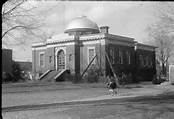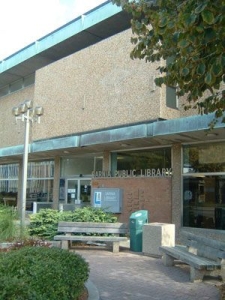by Carl Hnatyshyn for Sarnia This Week
(2015) From the artwork of Tom Thompson and Salvador Dali to the unique inventions of the group dorkbot, an audience of approximately 100 people were treated to a captivating look at the past, present and future of Sarnia’s art scene, as Jane Hunter and Darryn Doull spoke at the Central Forum speaker series on Jan. 27 with their presentation Transitions in Art. Hunter, an internationally renowned artist and Doull, the assistant curator of the Judith & Norman Alix Art Gallery spoke about Sarnia’s roots as a vibrant centre of arts and its fascinating trajectory for the future.
Hunter is a familiar face on Sarnia’s art scene, a prolific artist whose watercolour paintings have been exhibited from one end of the globe to another. A life member of the Canadian Society of Painters in Watercolour, the Ontario College of Arts graduate has been plying her trade for over four decades with her paintings proudly displayed in private collections from Sarnia to Japan to South Africa, with one of her paintings presented to Queen Elizabeth II during the diamond jubilee for inclusion in Her Majesty’s collection in Windsor Castle.
The engaging and erudite Hunter discussed the evolutionary history of the gallery in Sarnia, noting that one of her first memories came from sitting quietly in the old Sarnia Carnegie Library’s children’s section, listening to Sadie Knowles read stories to an assembled group of children during story hour. While Knowles read tales to the children, Hunter’s eyes kept gazing up at a particularly vivid landscape painting that hung above the library’s stone fireplace, a work of one of Canada’s venerated Group of Seven.
“I had no idea at the time that Mrs. Knowles and that painting would be so important both to me and the history of art in Sarnia,” she said.
Knowles was one of ten women who formed Sarnia’s Women’s Conservation Art Association during the First World War. The association was originally composed of a number of women and men who gathered rags and paper to recycle in order to help Canadian soldiers in the war effort. Following the armistice in 1918, ten women from the group decided to focus on building an awareness of the arts in Sarnia and joined forces with Dr. Norman Gurd, then a member of the Sarnia Library Board, to create a new public art gallery.
“Mr. Gurd was a visionary,” she said. “He believed that a country does not become a nation until it knows and produces art.”
Using the Carnegie Library as their base, Gurd and the WCAA made a conscious decision to push boundaries and reach for the stars, to bring some of the best contemporary art to the region, Hunter said. Through Gurd’s connections with friends and associates in Toronto, he was able to amass a selection of modern paintings that led to Sarnia’s first exhibition in 1920. Among the 20 paintings on display during that first exhibition were works by Tom Thompson and other members of the Group of Seven. Building on the success of that early show, Gurd and the WCAA worked tirelessly to bring more modern, contemporary art to Sarnia. The group managed to procure some wonderful pieces of art for the Carnegie Library – the paintings purchased during those inaugural years became the core of the collection of the gallery today, Hunter said. Gurd organized traveling exhibitions to nearby cities and towns such as London, St. Thomas and Chatham to display Sarnia’s burgeoning and eclectic collection and the group were pioneers when it came to community outreach programs.
“Sarnia was the first community in Canada to have an active program to have an appreciation of art and the purchasing of art,” she said. “We have one of the best collections of Canadian art for a city of its size, and it’s because of the work of the ladies in the Conservation Association and the enthusiasm of Mr. Gurd, who gave them the idea and carried on and made it happen.”
In 1961 the Sarnia Public Library and Art Gallery was built and included a large space to further engender a greater appreciation of the arts. This new space thrived under chief librarian Reg Bradley, Hunter said, who was a champion of providing and procuring some of the most valued and interesting pieces of art available, an incredibly impressive feat considering Sarnia’s size. Hunter joked that such was Bradley’s passion for art, as chief librarian he spent more time in the gallery section of the new facility rather than in the library section.
“The exhibits during those years were fantastic,” Hunter said, with Group of Seven paintings hanging alongside contemporary works by renowned artists including Harold Town, Maggie Piggott and Florence Wyle. By the early 1990s the facilities at Sarnia Public Library became untenable to support an art gallery, Hunter said.
The lighting systems, the humidity and temperature controls weren’t working properly. The newly amalgamated County of Lambton had recently taken over jurisdiction of the gallery and commissioned a report found that refurbishing the space would be prohibitively expensive. Council decided instead to move the gallery into a space in the Bayside Centre in 1994, which became the Lambton Gallery.
While the space in the Bayside Mall was equipped with good lighting and properly functioning humidity controls, space was inadequate for the size of the collection, Hunter said. “But they made the best of it,” she said, noting that during that time the gallery began several outreach programs that attracted many young and talented aspiring artists into its fold.
Finally, shortly after Lisa Daniels became curator in 2007 and spurred on by a financial incentive offered by the federal government, the gallery moved into its current location inside the Thom building on the corner of Christina and Lochiel Streets. While some didn’t agree with moving the gallery to its current downtown location, Hunter was one of the biggest proponents of the move. “I agreed because the old Thom building seemed to represent to me the state of downtown at that time. It was very seedy,” Hunter said, taking a pause and smiling. “I could probably think of other words to describe it, too.”
The Judith & Norman Alix Art Gallery was open to the public in October 2012. “And now it really is the cornerstone of downtown,” she said. “It’s really helped the rejuvenation of downtown.” Sarnians have always had an incredibly vivacious and deep passion for the arts, Hunter said, and the efforts of countless community members to bring the best of the best to the gallery have underlined that enthusiasm.
“There’s always been a strong feeling for art in the community. Perhaps it started in the early days, as I was talking about. But it has carried on,” she said. “It’s a very arty community…and that’s a very good thing.”
Assistant curator at the Judith & Norman Alix Art Gallery Darryn Doull fully agreed with Hunter’s assertion as he took over the second part of the presentation, talking about the gallery’s present and future.
“Sarnia is a very artist-friendly community and of all the arts too. There are an inordinate number of musicians and visual artists and writers seem to be living here and growing up here and sharing with each other,” he said.
“Jane talked about the Sarnia art movement and I think that culture still exists in a different way today. If you pull back the blankets a little bit, it’s all there and everyone has an art form they’re practicing it seems,” Doull said.
The Sarnia born and bred Doull spent his high school years working and volunteering in the Lambton Gallery prior to going to the University of Guelph. As soon as he graduated, Doull headed home to join the team as it entered into its new digs on Christina Street.
The 26 year-old spoke about several aspects of the gallery’s plans for the future, as well as an exciting personal adventure coming in late February, a four-week residency in Fogo Island, Newfoundland. The assistant curator was one of two people nationally to be selected for Fogo Island’s Art Young Curator Residency, which identifies individuals who have the drive, determination and ability to contribute to contemporary Canadian visual culture.
“I can’t wait to get out and immerse myself in the community, learn as much as I can while I’m out there and bring that all back to Sarnia,” he said.
Doull also spoke of the numerous outreach programs currently being undertaken at the gallery focusing on two near and dear to him, Inspirational Memories and dorkbot.
Inspirational Memories is a partnership with the Sarnia-Lambton chapter of the Alzheimer’s Society, and involves approximately 20 individuals both conversing about a piece of art and making art of their own in hands-on sessions, Doull said.
“We’re really really lucky to be working with the Alzheimer’s Society of Sarnia-Lambton,” he said. “Numerous studies find that this engagement with visual culture and communal discussion really helps delay the onset of dementia. So for these people, it’s a chance for them to reconnect to past hobbies that they used to do before the onset of dementia.” The program is profoundly moving, particularly when participants bring up old memories or making new creations, Doull said.
“I’ve witnessed a number of sessions and it is truly remarkable what the power of this sort of program can do for people,” he said.
dorkbot is an informal group of likeminded people of all ages who are interested in tinkering and fixing objects, and who “like to do weird things with electricity.” The group meets intermittently to compare and learn about other group members’ unique creations. Recently, dorkbot participants created their own, completely distinctive musical instruments, some of which were played onstage mere days after their creation. After talking about programs currently being offered at the gallery, Doull shifted the focus to the future and shared his undeniable excitement with the crowd surrounding the upcoming Masterworks of the Beaverbrook Art Gallery coming to the Judith & Norman Alix Art Gallery this fall.
The Beaverbrook exhibition will be one of enormous cultural significance for Sarnia, Doull said. New Brunswick’s world renowned and highly acclaimed gallery contains some of the most significant holdings of British and international art in North America, and many significant works will be making their way to Sarnia in October – the only stop the collection will be making in all of Ontario – at the gallery.
Works coming to Sarnia will include a number of significant and noteworthy paintings such as Lucien Freud’s Hotel Bedroom, J.M.W. Turner’s Fountain of Indolence and a 13 foot tall Salvador Dali painting, Santiago El Grande.
“Everybody at the gallery is super excited about it. We’ve been working on it for months already, planning out how the days will look, what special programs we can do and all the different outreach we’ll be doing…it’s a major exhibition to pull together,” Doull said. “It’s really going to be a coming-of-age for the gallery,” he continued. “Something like this goes so far above and beyond the exhibitions we’ve been able to have so far.”
“We’re hope that everybody else in the community takes advantage of having this in Sarnia,” he said.



